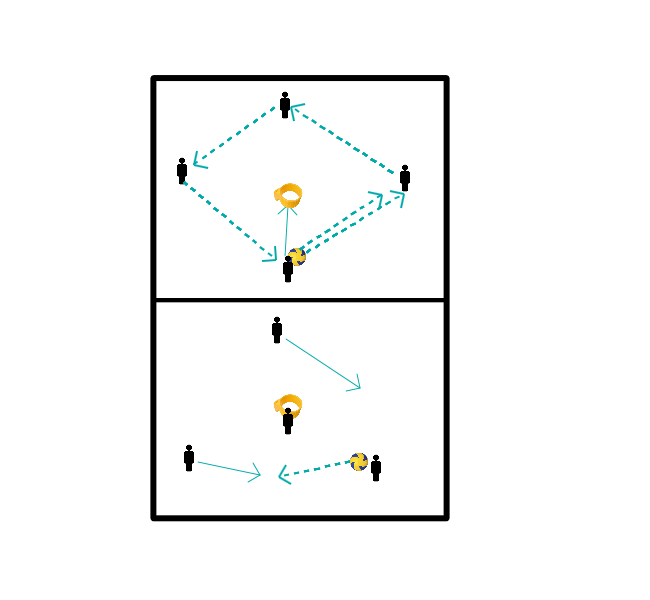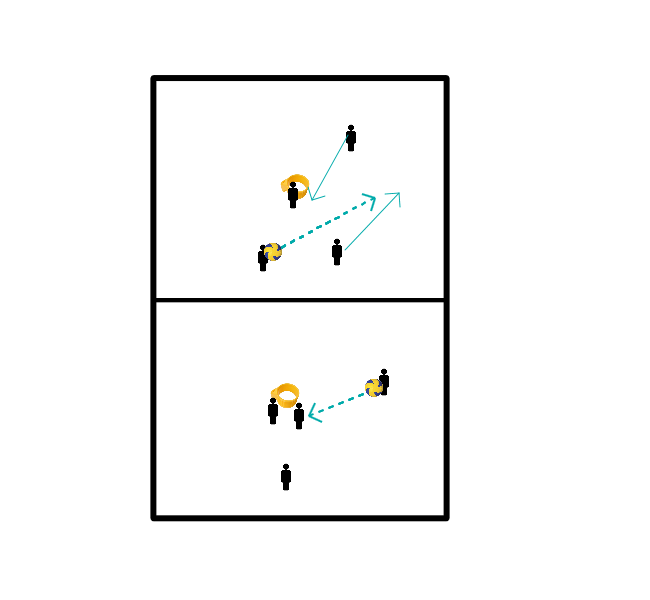Korfball drills for technique warming-up
The trainer tells the children to warm up in a section or around baskets. It is important that the children don't run too fast, because it is warming up.
When the muscles are warmed up, the trainers can add variation to the exercise. At a 'Yes' or whistle signal from the trainer, the children must respond.
Variations you can introduce:
- Changing the direction of running
- Sprint for a few seconds
- Walk sideways
- Cross pass
- Tapping the ground (followed by jumping in the air)
Inshort: exercises in catching balls that bounce or roll at the right moment.
Organisation: each team has a ball and a basket.
- Three teams,
- the declarator stands in the middle under the basket.
- He rolls the ball a few metres away.
- As soon as the ball is loose, the other two may run.
- Who has the ball first, can make a turnaround or an attack with a pass?
- After 3 substitutions.
Divide your team into two teams.
You will stand by a basket per pair and follow exercises that your trainer indicates.
Exercises can be:
- 3 laps of passing balls (catch your own ball) (depending on the number of baskets you can make more or less laps)
- 3 laps in out shot (pass to the outside)
- 3 laps of short chance
- 3 laps pass balls late (take overhead)
- 15 dots per person (per 2 on 1 basket)
- 10 free balls per person (per pair on 1 basket)
- 10x shot from standstill
- 10x shot from movement (try on 1 leg)
Start line-up
Two groups at the first two pawns.
Exercise
- The first in line runs to the hoop and goes through the hoop from the bottom, so the hoop goes over their heads.
- Then he runs through the defence posture to pawn two and circles this in 4 circles.
- Finally, he runs to pawn 3 and scores before he can run back to pawn 1 and tap the next one in line.
Set-up distance:
Hoop from pawn 1: 5 meters.
Pawn 2 from the hoop: 5 meter.
Pawn 3 from pawn 2: 5 meter.
Pole from pawn 3: 4 meter.

- Put out a square of 20 by 20 with hats.
- In the middle put balls (1 less than the number of players)
- The players walk in circles around the hats
- At the whistle they run in and try to get a ball
When you have a ball you can try to shoot (penalty throw - distance) and if you score you have a point, at every new round one ball less in the middle. The players who don't get the ball keep running.
Children run and throw the ball over within a defined area.
- There is one ticker.
- Who has the ball may not be tagged.
- You may hold the ball for 8 seconds.
- The catcher may not stay with the person with the ball.
Make it more difficult with several balls.
- Make 2 squares of 4.
- The attack takes the ball from the trainers.
- When the defence has intercepted the ball, they first pass it back to the trainers.
- When a goal is scored, the team gets a bonus and can take the ball back out.
Do give orders, for example:
- Start in a diamond. Let the ball go around 1 time.
- The player in front throws the ball next to him/her one more time and catches it.
- The other players continue playing. The player who has the ball now chooses whether he wants to throw to the left or to the right. The other players run to the ball to pick it up. The ball is thrown and the player immediately runs a long line.
The long line is nudged and the thrower comes alongside. The other player walks behind the basket to walk into the support. The other two are going to attack.


Place 2 cones at the same height 4 meters apart.
Start with a pawn at 6, 12 and 20 metres.
Divide the team in 2 groups. Fight each other in relay. Number 2 can start when number 1 is at the 2 pawns. Which team is back first?
Repeat 3 times
Place a number of cones/caps 2 to 3 metres apart. Make two rows of cones and divide the team into two groups.
The exercise is quite simple. One pawn sprints and one pawn knees high. Go behind each other
Inshort: exercises in catching balls that bounce or roll at the right moment.
Organisation: one ball per pair or trio.
(a) The numbers 1 and 2 of each pair stand next to each other. Number 1 rolls the ball a few metres away. Number 2 has to get the ball, pick it up and throw it back as fast as possible. Change after 5 games. Make sure the players 'get' the ball as soon as possible by putting one hand on it as soon as possible.
b ) As a., but now number 1 throws the ball away with a small curve, in such a way that it bounces on the ball at a distance of about 4 metres (and then makes a bounce of about half a metre high). Number 2 must try to get the ball as soon as possible after the bounce.
c ) As b., but now number 1 drops the ball from a height of 1.5 metres just in front of number 2. He/she has to try again to get the ball as soon as possible after the bounce. It will appear that almost everyone lets the ball rise a little and then catches it. Wrong (in the meantime an opponent can quickly put his/her hand on the ball). At the very moment that the ball is about to come up, the hand should be placed on the ball Take the ball!
Start line-up
Two groups at the first two pawns.
Exercise
The first in line runs to the hoop and goes through the hoop from the bottom, so the hoop goes over their heads. Then he runs through the defence posture to pawn two and circles this in 4 circles. Finally, he runs to pawn 3 and scores before he can run back to pawn 1 and tap the next one in line.
Distance set up:
- Hoop from pawn 1: 5 meters.
- Pawn 2 from the hoop: 5 meter.
- Pawn 3 from pawn 2: 5 meter.
- Pole from cone 3: 4 meter.

Inshort: exercises in catching balls that bounce or roll at the right moment.
Organisation: One ball per pair or trio.
- The numbers 1 and 2 of each pair stand next to each other. Number 1 rolls the ball a few metres away. Number 2 has to get the ball, pick it up and throw it back as quickly as possible. Change after 5 games. Make sure that the players 'get' the ball as quickly as possible by putting one hand on it as soon as possible.
- Like 1., but now number 1 throws the ball away with a small curve, in such a way that it bounces about 4 metres away (and then makes a bounce of about half a metre high). Number 2 must try to get the ball as soon as possible after the bounce.
- As 2, but now number 1 drops the ball from 1.5 metres just in front of number 2. Number 2 must again try to get the ball as soon as possible after the bounce. It will appear that almost everyone lets the ball rise a little before catching it. Wrong (in the meantime an opponent can quickly put his/her hand on the ball). At the very moment that the ball is about to come up, the hand should be placed on the ball Get that ball!
- Three teams, the person who gives the information stands in the middle. He rolls the ball a few meters away. As soon as the ball is loose, the other two may run. Who has the ball first? After 3 substitutions.








